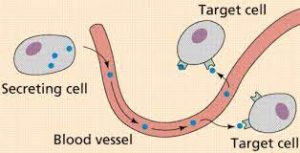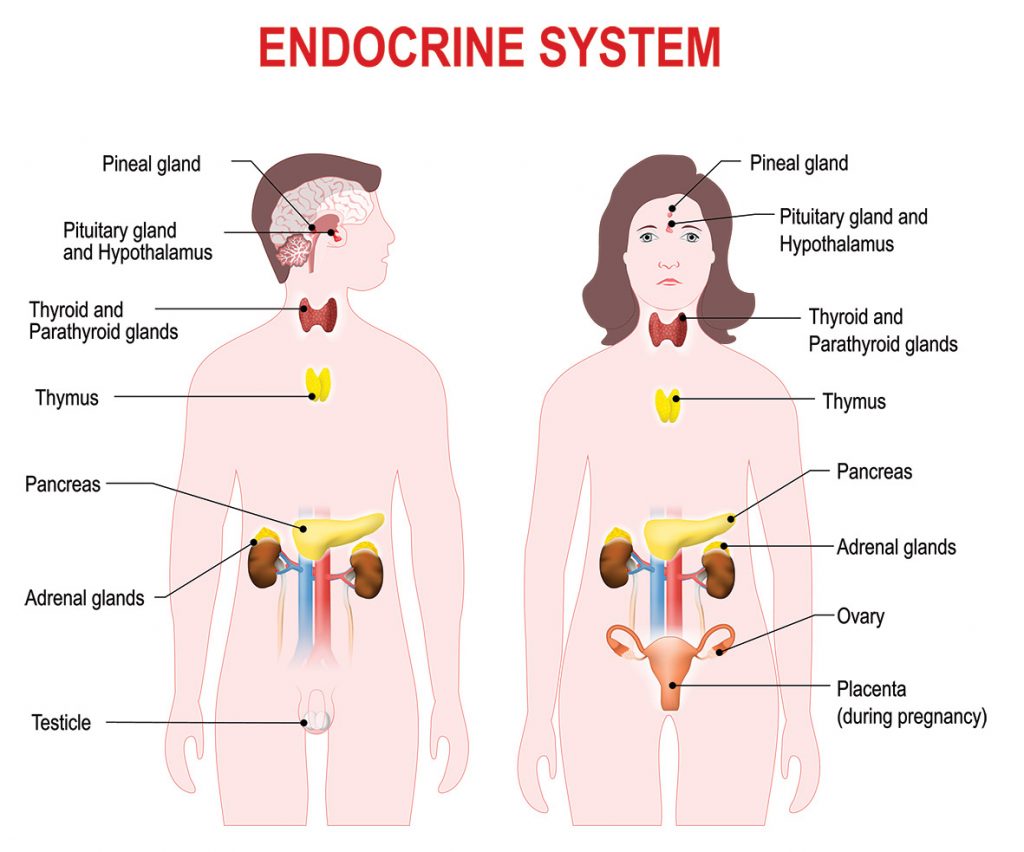The endocrine glands produce chemicals called hormones and pass them directly into the bloodstream. Hormones can be thought of as chemical messages. From the bloodstream, hormones communicate with the body by targeting their target cell to cause a particular change or effect in that cell. The hormone can also create changes in the cells of surrounding tissues (paracrine effect).
The endocrine system works with the nervous system and the immune system to help the body cope with different events and stresses. This branch of medicine, related to the study of the endocrine system, is called endocrinology and is practised by endocrinologists. The field is expanding rapidly due to the understanding of the cellular pathways that stimulate hormones and the discovery of new hormones and their actions.
Exocrine glands
An exocrine gland, as opposed to an endocrine gland, is a gland that secretes substances (electrolytes, proteins, or enzymes) directly to a target site through ducts or tubes. Some examples include:
- Salivary glands
- Sweat glands
- Sebaceous glands
- the pancreas
The pancreas is both an endocrine and exocrine organ. It releases certain enzymes to aid in digestion that reach the intestine through the pancreatic duct. The endocrine pancreas also releases hormones like insulin and glucagon, which are hormones predominantly related to glucose metabolism, into the bloodstream.
Functions of the endocrine system
Some of the functions of the endocrine system include:
- Increase
- Repair
- sexual reproduction
- Digestion
- Homeostasis (constant internal balance).
How do hormones work?
A hormone communication will only act on a part of the body if it “fits”. A hormone can be thought of as a key, and its target site (such as an organ) has specially shaped locks in the cell walls. If the hormone fits into the cell wall, it will work. Hormones can trigger a cascade of other signalling pathways in the cell to cause an immediate effect (for example, insulin signalling leads to rapid glucose uptake in muscle cells) or a more delayed effect (glucocorticoids bind to DNA elements in a cell). to activate the production of certain proteins, which take time to produce).
The endocrine system is a tightly regulated system that keeps hormones and their effects at the proper level. One way to accomplish this is through “feedback loops.” Hormone release is regulated by other hormones, proteins, or neural signals. The released hormone then has its effect on other organs. This effect on the organ feeds back the original signal to control any further release of hormones. The pituitary gland is well known for its feedback loops.

Glands and endocrine organs
The major glands and organs of the endocrine system include:
- Pituitary gland: it is inside the brain. It monitors the other glands and keeps hormone levels in check. It can cause a change in hormone production elsewhere in the system by releasing its own “stimulating” hormones. The pituitary gland is also connected to the nervous system through a part of the brain called the hypothalamus. The hormones released by the pituitary gland are gonadotropins (LH and FSH), growth hormone (GH), thyroid-stimulating hormone (TSH), adrenocorticotropic hormone (ACTH), prolactin, antidiuretic hormone, and oxytocin.
- Thyroid gland: It is located in the neck in front of the trachea. It releases thyroid hormone (T4 and T3) which is necessary for metabolism and body homeostasis. It is controlled by TSH, which is produced by the pituitary gland through a feedback loop.
- Parathyroid Gland: There are usually four parathyroid glands that are located next to the thyroid gland. The parathyroid gland is involved in the regulation of calcium, phosphate, and vitamin D.
- Adrenal Glands: There are two adrenal glands that sit on top of each kidney. They produce a number of different hormones. The outer part of the gland (adrenal cortex) produces cortisol, aldosterone, and sex hormones. The centre of the adrenal gland (adrenal medulla) produces adrenaline. Adrenaline is an example of a hormone that is under the control of the nervous system.
- Pancreas: organ of digestion found within the abdomen. It produces insulin, which controls the amount of sugar in the bloodstream. It also produces other hormones such as glucagon and somatostatin.
- Ovaries: They are inside the female pelvis. They produce female sex hormones like estrogen.
- Testicles: hang in the male scrotal sack. They produce male sex hormones like testosterone.
Other lesser-known endocrine organs include:
1. Adipose tissue (fat tissue): recognized to be metabolically important. It releases hormones like leptin, which affect appetite, and is also a site of estrogen production. Insulin also acts on adipose tissue.
2. Kidneys: produce erythropoietin (EPO) which stimulates the production of red blood cells, produce renin which is needed to regulate blood pressure, and produce the active form of vitamin D (1-25 dihydroxy vitamin D3)
3. Gut: An increasing number of hormones in the gut are being investigated and are understood to affect metabolism and appetite. These include glucagon-like peptide 1 (GLP-1), appetite-stimulating ghrelin, and somatostatin.
Endocrine system problems
Numerous problems can occur in the endocrine system. These can be considered as excessive or deficient production of hormones. The endocrine organs are also prone to tumours (adenomas) that can overproduce hormones. Some endocrine system problems include:
- Diabetes: Too much sugar in the blood is caused by problems with insulin production. This includes type 1 diabetes (insulin deficiency) and types 2 diabetes (initially excessive, then insulin deficiency).
- Menstruation abnormalities: irregular menstruation or lack of menstruation. Some causes of this include polycystic ovary syndrome (PCOS), pituitary adenoma, or primary ovarian insufficiency (POF).
- Thyroid problems: when the gland is overactive (hyperthyroidism) or underactive (hypothyroidism). Thyroid nodules are common, but thyroid cancers are rare.
- Parathyroid problems: An enlargement of one or more of the parathyroid glands can lead to high levels of calcium in the blood (hypercalcemia).
- Pituitary adenomas: These are tumours of the pituitary gland that can make too much of a certain hormone or cause hormone deficiencies. These tumours can be small (microadenomas) or large (macroadenomas).
- Neuroendocrine tumours: These are rare tumours of certain endocrine glands (usually the adrenal gland, pancreas, or small intestine). These can include too much adrenaline released by the adrenal gland (pheochromocytoma) or too much 5-HIAA hormone from a carcinoid tumour causing diarrhoea and flushing.

